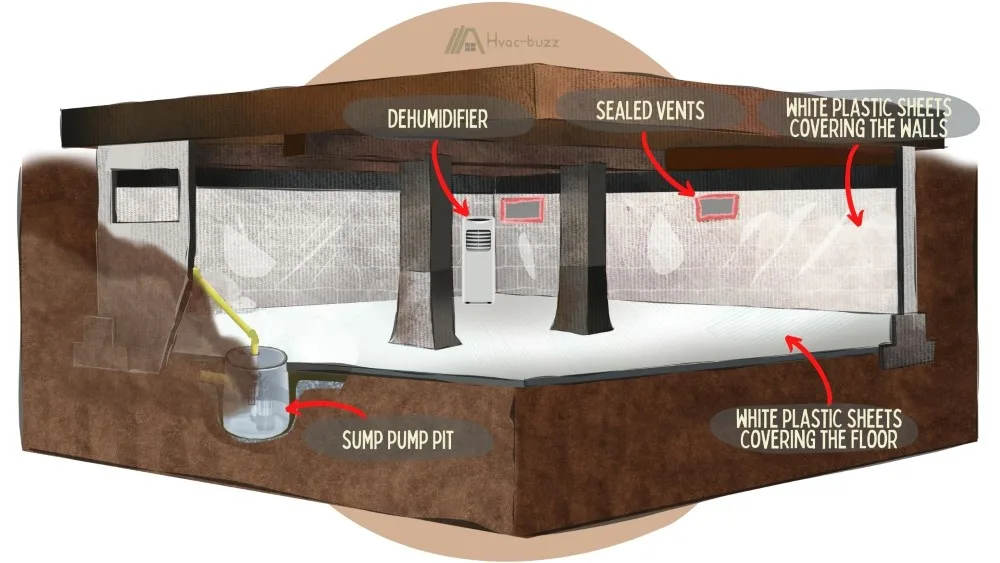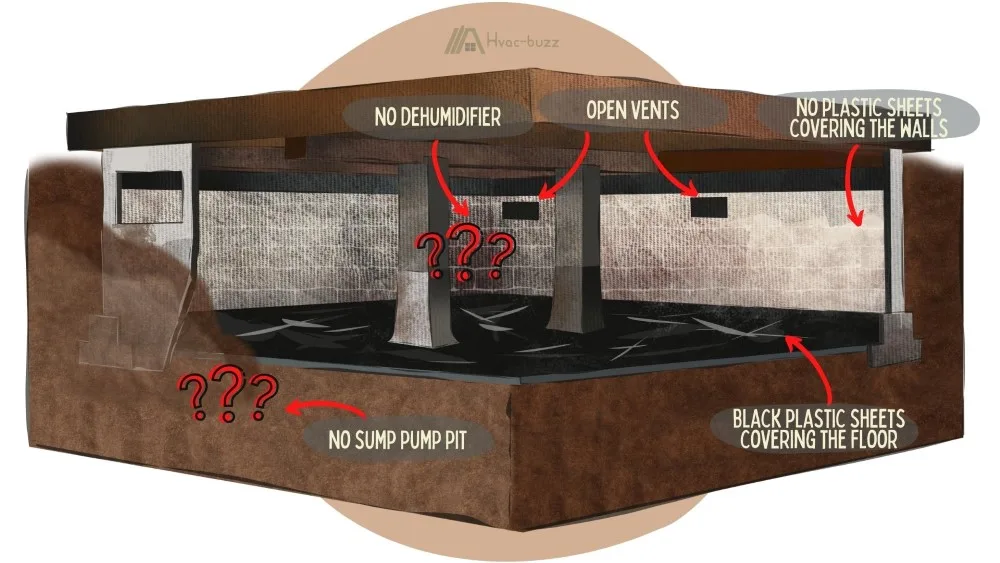Encapsulation and vapor barriers serve the same main purpose of controlling the environment in a crawl space. They control humidity and reduce mold problems. They also improve the air quality of your home, since bad air quality in your crawl space can infiltrate your home through the HVAC system.
The most distinguishing difference between the two is the fact that encapsulation has a seal of white plastic that covers 100% of the ground of your crawl space while a vapor barrier utilizes black plastic that only covers the floor of the crawlspace.
Encapsulation also commonly uses both a dehumidifier as well as a sump pump to ensure reduce moisture. Vapor barriers use neither and therefore are a lot cheaper.

Encapsulation involves completely sealing off a crawl space from air and moisture and necessitates supplying the encapsulated space with a sump pump and dehumidifier. Vapor barriers seal the floor only, can be used in different spaces, and does not require dehumidifiers and sump pumps.
What is Encapsulation?

The Basics
Encapsulation is the process of sealing the entirety of your crawlspace with white plastic sheeting. This includes the floor as well as the walls of your crawlspace since these areas are all soil-adjacent. Each corner and seam must be completely sealed for the best results.
A sump pump and dehumidifier are important for the highly efficient functioning of your encapsulated space. A normal dehumidifier cannot be used in a crawl space, they are not powerful or able to withstand the environment.
Materials/Cost
White plastic sheeting is used for this project. This sheeting typically retails at about 50 cents per sq. ft. Other materials include seaming tape (amazon link), polyurethane caulk, termination bars, concrete screws (amazon link)/fasteners, and possibly chalk, a headlamp, and a rubber roller.
Location
Encapsulation is done in crawlspaces. These crawlspaces can be concrete, gravel, or any other type.
Benefits
A successful crawlspace not only keeps moisture and mold at bay but also discourages pest infestation. Good air quality in your crawl space makes entering the crawl space a lot more pleasant and also improves the quality of the rest of your home’s air as well.
Decreased moisture can also support the integrity of your foundations as well as deter termites from feasting on the wood of your foundation and flooring.
Because encapsulation utilizes both a dehumidifier as well as a sump pump, it is very efficient with water removal, even in more extreme conditions, such as a burst pipe.
A well-kept crawlspace can be utilized for all sorts of storage. Encapsulation in your crawl space will ensure that stored items will be preserved in ideal conditions for years to come.
Not only does encapsulation keep moisture out, but it can also keep heated air in. The sealing prevents air from escaping, which will do wonders for your electricity bill.
Drawbacks
Encapsulation involves the complete sealing of your crawlspace, which would apply to a large amount of square footage. This will lead to the use of more materials, which means greater difficulty, more time, and more cost.
The costs don’t stop at the white plastic sheeting and other materials. Sump pumps and dehumidifiers are highly recommended for optimal results. A dehumidifier adds to the cost and sump pump installation is certainly not cheap.
If just one junction or seam in your white plastic sheeting is not sealed properly, this can damage the integrity of the encapsulation. Moisture can enter and lead to sharp declines in your crawl space air quality, which can then affect the air quality of the rest of the house.
Although storage would be ideal in an encapsulated crawl space because of the closely regulated temperatures and moisture, the reality is that in order to gain access to the stored items, you would break the seal often, making it less efficient.
A crawl space without encapsulation can lead to some fairly negative scenarios, but once your crawl space is altered and encapsulated, its maintenance must be more regular, adding more maintenance for you to do around the house. Your crawl space can no longer be ignored!
It is important to note that configuring your HVAC system around your crawl space is highly necessary. For example, it might sound convenient to vent bathroom air into your crawl space, but it goes against residential codes and can cause all sorts of problems.
If you are interested in a more extensive look at the benefits and drawbacks of crawl space encapsulation, you can find this information in Pros and Cons of Crawl Space Encapsulation.
What is a Vapor Barrier?

The Basics
A vapor barrier involves the sealing of just the floor of your crawlspace. It utilizes black plastic sheeting (amazon link), which is 6 mm (0.2″) in thickness. Other thicknesses can be utilized but 6 mm will last longer.
Vents in the crawl space are not sealed and dehumidifiers, as well as sump pump connections, are not necessary.
Materials/Cost
Brands such as Acculevel and Visqueen are popular types of black sheeting plastic used for this project. They are both 6 mm thick and last about 5 to 10 years before they begin to deteriorate. They cost about a dollar per sq. ft.
Other supplies needed include a caulk gun, hammer, straight edge, tape measure, and utility knife.
Alternatively, in some situations, Dylok can be used as a vapor barrier instead of plastic sheeting. Only if the crawl space floor is concrete.
Location
Unlike encapsulation, vapor barriers are used in more than just crawl spaces. They are also used, when needed in a wetter climate, in insulation.
In colder climates, they are installed on the interior of the insulation. In warmer climates, they are installed on the outside of the insulation. Insulation alone will not reduce humidity!
Vapor barriers are set up in this way since in colder areas, much of the moisture is coming from the consistent use of heating.
In warmer, more humid areas, much of the moisture is coming from the outside since the inside is drier from AC usage.
Benefits
Vapor barriers have many of the same pros as encapsulation since they serve a similar purpose.
Vapor barriers can improve the quality of air in a crawl space as well as the air quality of the rest of your home since crawl space air is distributed throughout the whole home. Decent air quality is important for those with allergies and breathing issues such as asthma.
Since vapor barriers can also be used in insulation, they can protect more areas of the home from the damaging effects of moisture.
Not only can the crawl space be protected from the infestation of mold and pests of all shapes and sizes, but anywhere that vapor barriers are installed.
Unlike encapsulation, vapor barriers do not require dehumidifiers and a sump pump. This can greatly reduce the cost as well as the complexity of the project of installing vapor barriers.
Vapor barrier-sealing also requires fewer materials since only the floor of the crawl space is being covered, not the walls as well. Fewer materials would minimize cost as well as work.
Drawbacks
As with encapsulation, adding vapor barriers to your crawl space requires maintenance. It is not the kind of project that can be done once and the crawl space never has to be altered again.
This is especially true since black sheeting plastic, as well as the white sheeting plastic for encapsulation, starts to deteriorate and break down over time. Depending on the brand, materials, and thickness, plastic sheeting may only last from 1 to 6 years.
Although the lack of need for a dehumidifier as well as a sump pump does save time and money, it does make the sealing less reliable. This is also because vapor barriers only cover the flooring of your crawl space.
The temperature and humidity of your crawl space won’t be as regulated as they would be if the crawl space was encapsulated.
Table of Differences Between Encapsulation and Vapor Barriers
| Encapsulation | Vapor Barriers |
| More effective at moisture removal/blocking and temperature control | Less effective at moisture removal/blocking and temperature control |
| Materials: white plastic sheeting, seaming tape, polyurethane caulk, termination bars, concrete screws/fasteners, and possibly chalk, a headlamp, and a rubber roller. | Materials: black plastic sheeting, caulk gun, hammer, straight-edge, tape measure, and utility knife. |
| Price of sheeting: ~ $0.50 per sq. ft | Price of sheeting: ~ $1.00 per sq. ft |
| Location of sheeting: all walls and flooring of crawl space | Location of sheeting: just flooring of crawl space (can also be used in insulation of walls of home) |
| Overall price: higher (dehumidifier and sump pump as well as more square footage) | Overall price: lower (higher price per square foot but less square footage and no dehumidifier and sump pump needed) |
| Shares the same drawbacks as vapor barriers but is more expensive. | Shares the same drawbacks as encapsulation but is not as effective. |
Should I Go With Encapsulation or a Vapor Barrier?
Choosing whether you should install encapsulation or a vapor barrier in your crawl space is largely dependent on the local climate and your budget.
Encapsulation would be a wise choice if the local climate is fairly wet and if you are experiencing low air quality consistently. This would also be wise if you or someone living with you has breathing issues or allergies and all other solutions are not working.
Encapsulation ensures rigid monitoring of temperature and humidity throughout your home. Although it is more expensive because of its larger area as well as a need for a dehumidifier and a sump pump, encapsulation is much more reliable than a vapor barrier.
The conditions where a vapor barrier will suffice is a climate that is not overwhelmingly wet. This means that dampness and air quality could be improved but is not in dire need of action.
Vapor barriers would also do well for when the project runs on a tight budget and limited time since less area is covered.
Sources
https://www.stegoindustries.com/blog/what-supplies-will-i-need-to-encapsulate-my-crawl-space
https://crawlspacemedic.com/do-i-need-a-vapor-barrier-in-my-crawl-space/
https://www.attainablehome.com/when-do-you-need-a-vapor-barrier/
https://www.familyhandyman.com/project/how-to-install-a-vapor-barrier-in-the-crawlspace/
https://acculevel.com/crawl-space-need-vapor-barrier/
https://crawlspacework.com/2020/04/encapsulation-vs-vapor-barrier/
https://www.sedonawaterproofing.com/crawl-space-encapsulation-vs-vapor-barrier/
https://www.neutocrete.com/crawl-space-encapsulation-the-truth-about-plastic-liners.html

